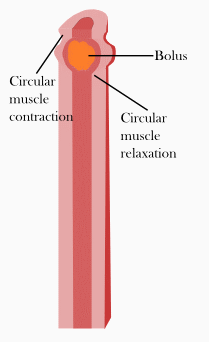Enteric nervous system
| Enteric nervous system | |
|---|---|
gastrointestinal system. | |
| Identifiers | |
| Acronym(s) | ENS |
| MeSH | D017615 |
| FMA | 66070 |
| Anatomical terminology] | |
The enteric nervous system (ENS) or intrinsic nervous system is one of the three main divisions of the
The enteric nervous system is capable of operating independently of the brain and spinal cord,
Structure
The enteric nervous system in humans consists of some 500 million
The neurons of the ENS are collected into two types of
Auerbach's plexus
Auerbach's plexus, also known as the myenteric plexus, is a collection of fibers and postganglionic autonomic cell bodies that lie between the circular and longitudinal layers of the muscularis externa in the gastrointestinal tract.[
Submucosal plexus
The submucosal plexus (also known as Meissner's plexus) is found in the submucosal layer of the gastrointestinal tract.[15] It was discovered and named by German physiologist Georg Meissner. It functions as a pathway for the innervation in the mucosa layer of the gastrointestinal wall.
Function
The ENS is capable of autonomous functions[16] like the coordination of reflexes; although it receives considerable innervation from the autonomic nervous system, it can and does operate independently of the brain and the spinal cord.[17] Its study is the focus of neurogastroenterology.
Complexity
The enteric nervous system has been described as a "second brain" for several reasons. The enteric nervous system can operate autonomously. It normally communicates with the central nervous system (CNS) through the parasympathetic (e.g., via the vagus nerve) and sympathetic (e.g., via the prevertebral ganglia) nervous systems. However, vertebrate studies show that when the vagus nerve is severed, the enteric nervous system continues to function.[7]
In vertebrates, the enteric nervous system includes
The enteric nervous system has the capacity to alter its response depending on such factors as bulk and nutrient composition.
Peristalsis

Peristalsis is a series of radially symmetrical contractions and relaxations of muscles which propagate down a muscular tube. In humans and other mammals, peristalsis is found in the smooth muscles of the digestive tract to propel contents through the digestive system. The word is derived from New Latin and comes from the Greek peristallein, "to wrap around," from peri-, "around" + stallein, "to place". Peristalsis was discovered in 1899 by the work of physiologists
Segmentation
Segmentation contractions are the contractions in intestines carried out by the smooth muscle walls. Unlike peristalsis, which involves the contraction and relaxation of muscles in one direction, segmentation occurs simultaneously in both directions as the circular muscles alternatively contract. This allows for thorough mixing of intestinal contents, known as chyme, to allow greater absorption.
Secretion
The secretion of
Clinical significance
Neurogastroenterology encompasses the study of the brain, the gut, and their interactions with relevance to the understanding and management of gastrointestinal motility and functional gastrointestinal disorders. Specifically, neurogastroenterology focuses on the functions, malfunctions, and the malformations of the sympathetic, parasympathetic, and enteric divisions of the digestive tract.[25] The term also describes a medical sub-specialism of gastroenterology dedicated to the treatment of motility and functional gastrointestinal disorders.
Functional gastrointestinal disorders
Functional gastrointestinal (GI) disorders are a class of gastrointestinal disorders where there is a malfunction in the normal activities of the gastrointestinal tract, but there are no structural abnormalities that can explain the cause. There are rarely any tests that can detect the presence of these disorders. Clinical research in neurogastroenterology focuses mainly on the study of common functional gastrointestinal disorders such as irritable bowel syndrome, the most common functional GI disorder.[26]
Motility disorders
Motility disorders are the second classification of gastrointestinal disorder studied by neurogastroenterologists. Motility disorders are divided by what they affect, with four regions: The esophagus, the stomach, the small intestines, and the large intestines. Clinical research in neurogastroenterology focuses mainly on the study of common motility disorders such as gastroesophageal reflux disease, the damage of the mucosa of the esophagus caused by rising stomach acid through the lower esophageal sphincter.[27]
Gut ischaemia
ENS function can be damaged by ischemia.[28] Transplantation, previously described as a theoretical possibility,[29] has been a clinical reality in the United States since 2011 and is regularly performed at some hospitals.[citation needed]
Additional images
-
The myenteric plexus of a rabbit. X 50.
-
The submucosal plexus of a rabbit. X 50.
Neurogastroenterology societies
- American Neurogastroenterology and Motility Society[30]
- European Society of Neurogastroenterology and Motility[31]
See also
- Basal electrical rhythm
- Homeostatic emotion
- Gut–brain axis
- Human gastrointestinal tract
References
- ^ ISBN 978-1-4051-7344-5.
- ISBN 978-1-4160-6257-8.
- ISBN 978-0-19-856878-0.
- S2CID 7401456.
- S2CID 34066966.
- ^ ISBN 0-06-018252-0.
- ^ PMID 12909562.
- ^ Pasricha PJ. "Stanford Hospital: Brain in the Gut - Your Health". YouTube.
- PMID 25916523.
- PMID 24106499.
- ^ Young E. "Gut Instincts: The secrets of your second brain". New Scientist. Retrieved 8 April 2015.; alternate source at website: "NeuroScienceStuff". Archived from the original on 4 May 2013.
- ^ p. 921
- ^ ISBN 978-1416045748.
- ^ "The Enteric Nervous System". Retrieved 29 November 2008.
- ^ Ross, Michael H, and Wojciech Pawlina. Histology: A Text and Atlas with Correlated Cell and Molecular Biology. Baltimore, MD: Lippincott Williams & Wilkins, 2006
- ^ "enteric nervous system" at Dorland's Medical Dictionary
- ^ Gershon, 1998 & 17.
- ^ Pasricha PJ. Brain in the Gut (video). Your Health. Stanford Hospital.
- PMID 25916523.
- PMID 24106499.
- S2CID 37969390.
- ^ Silverthorn DU (2007). Human Physiology. San Francisco, CA: Pearson Education, Inc.
- ^ Keet AS. "The Pyloric Sphincteric Cylinder in health and disease". Retrieved 18 November 2013.
- PMID 19008339.
- PMID 10457039.
- ^ Kumar A, Rinwa P, Sharma N (2012). "Irritable Bowel Syndrome: A Review". J Phys Pharm Adv. 2 (2): 97–108.
- S2CID 32509777.
- PMID 17375218.
- PMID 17369379.
- ^ ANMS - American Neurogastroenterology and Motility Society
- ^ ESNM - European Society for Neurogastroenterology & Motility
Further references
- Grosell M, Farrell AP, Brauner CJ, eds. (2010). Fish Physiology: The Multifunctional Gut of Fish. Academic Press. ISBN 978-0-08-096136-1.
- Gershon MD (1999). The Second Brain: A Groundbreaking New Understanding of Nervous Disorders of the Stomach and Intestine. Harper Perennial. ISBN 978-0-06-093072-1.
- Nosek TM. "Section 6/6ch2/s6ch2_29". Essentials of Human Physiology. Archived from the original on 2016-03-24.



